For players at any level, a bad pair of football socks can ruin a good game. Whether it’s soggy fabric that doesn’t breathe, thin soles that don’t cushion impacts, or socks that slip inside the boot, the results are always the same: discomfort, distractions, and sometimes even injury. Most buyers are used to choosing socks by length—ankle, crew, knee-high—but that only tells part of the story. What really matters is what the sock does, not just how long it is.
That’s why it’s time to look at football socks in a different way: by function. Let’s go beyond length and get into the real types of football socks—built for sweat control, grip, cushioning, odor prevention, and more.
Functional Types of Football Socks That Actually Matter
Blisters after a match. Socks slipping inside the cleats. Swollen toes from poor fit. These are the real issues football players complain about — not whether their socks are knee-high or mid-calf.
For years, brands categorized football socks based on length. But end users don’t care about centimeters — they care about comfort, grip, and staying dry. That’s why a growing number of brands are shifting toward a function-first approach. And for good reason: the market is no longer forgiving of generic designs.
Whether you’re a brand owner, retailer, or sourcing manager, understanding how each sock type solves specific on-field problems is now essential. Below, we break down functional football socks by performance feature — not outdated categories.
Moisture-Wicking & Breathable Football Socks
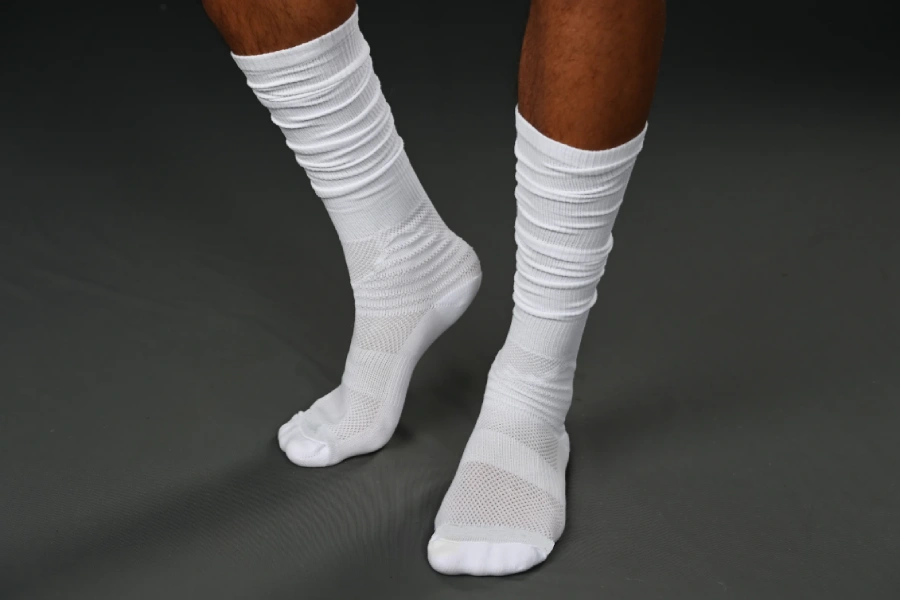
Problem they solve: Wet feet during summer training, overheating, and blistering during intense matches.
Who needs them: Athletes in warm climates, high-intensity match players, or anyone with sweaty feet.
How they work: These socks use lightweight synthetic fibers like polyester blended with mesh zones to maximize airflow and wick moisture away from the skin. This keeps the foot dry, cool, and less prone to friction-related blisters.
Popular product examples:
- Nike Dri-FIT socks
- Adidas Climacool
Customization possibilities:
- Varying mesh densities (top of foot vs. sides)
- Absorbent yarn ratios
- Color and pattern matching to team kits for a unified look
Anti-Odor & Antibacterial Football Socks
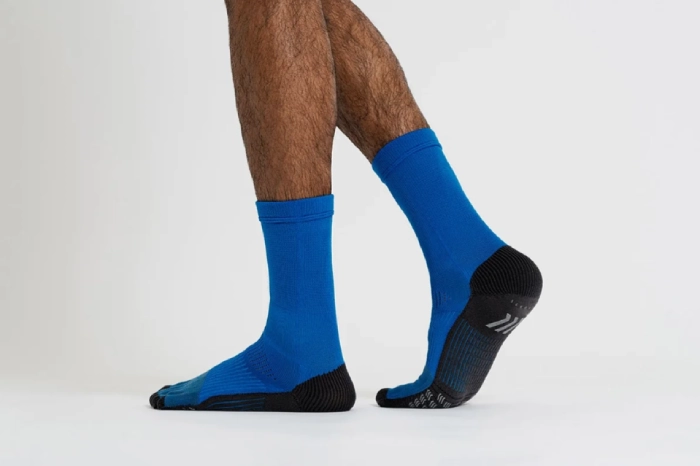
Problem they solve: Persistent odor from long hours in cleats, fungal infections, and unhygienic conditions in shared locker rooms.
Who needs them: Players with heavy training schedules, long match days, or sensitivity to bacterial growth.
How they work: These socks are made using bamboo fibers, copper yarns, or silver ion treatments that prevent bacteria from multiplying — which is the root cause of odor.
Popular product examples:
- Under Armour Charged Cotton
- Falke RU4 Cool
- Lululemon Training Socks
Customization possibilities:
- Certified antibacterial test reports (SGS, Intertek)
- Antimicrobial yarn integration in selected zones
- Knitting process documentation to support import regulations
Football Socks with Built-In Shin Guards
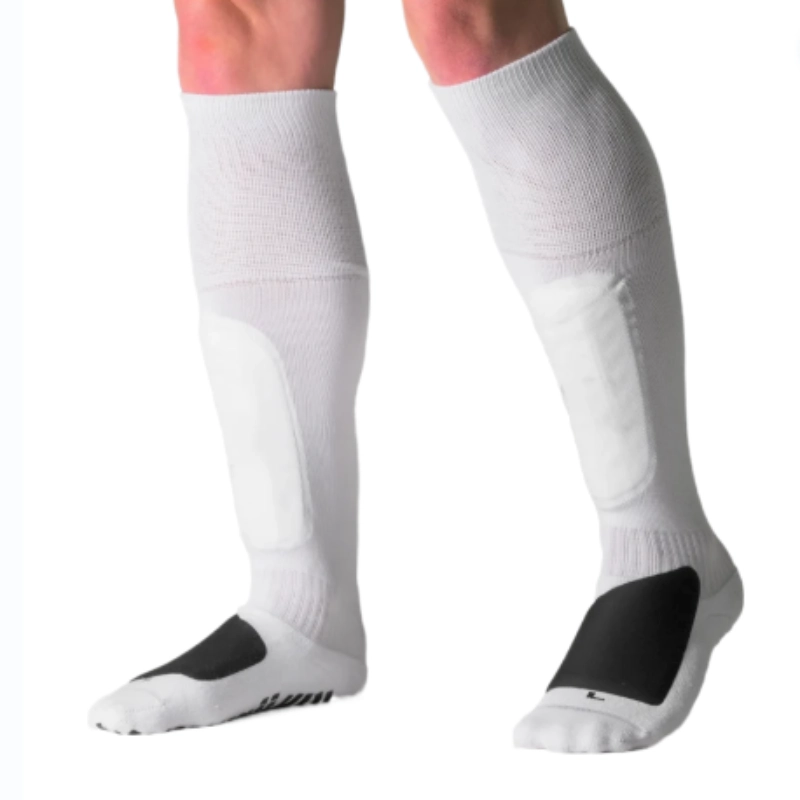
Problem they solve: Protecting shins from direct impacts, collisions, and tackles without needing separate shin guard sleeves.
Who needs them: Players across all positions seeking convenient, all-in-one protection with less bulk.
How they work: These socks integrate flexible yet durable shin guard padding directly into the fabric. The built-in guards conform to the leg shape, offering reliable impact absorption while maintaining comfort and mobility.
Why they are popular: Recently gaining traction due to their ease of use, reducing gear complexity, and improving on-field safety with minimal fuss.
Customization possibilities:
- Padding thickness and density options based on competition level
- Placement and size of shin guard inserts to fit youth or adult players
- Sock length tailored to match guard height and player preference
- Branding and color matching with team kits
Grip Football Socks
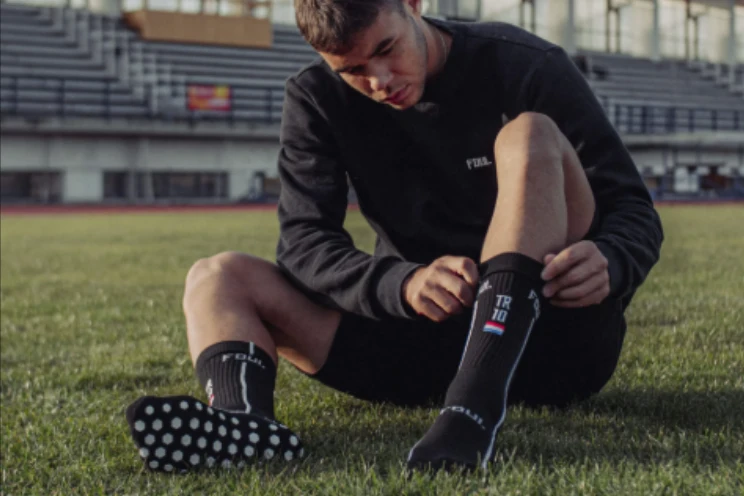
Problem they solve: Internal foot slippage inside boots, especially during explosive sprints, sharp cuts, or direction changes.
Who needs them: Pro athletes, elite academy players, and amateur players seeking better control and explosive movement.
How they work: These socks feature rubberized or silicone grip dots along the sole to create traction between foot and insole, preventing slide and increasing stability.
Popular product examples:
- Trusox
- TapeDesign
- SoxPro
- Nike Grip Socks
Customization possibilities:
- Grip dot shape (hex, line, circle), density, and layout
- Full-sole or forefoot-only grip
- Match grip layer color to brand palette
Compression Football Socks
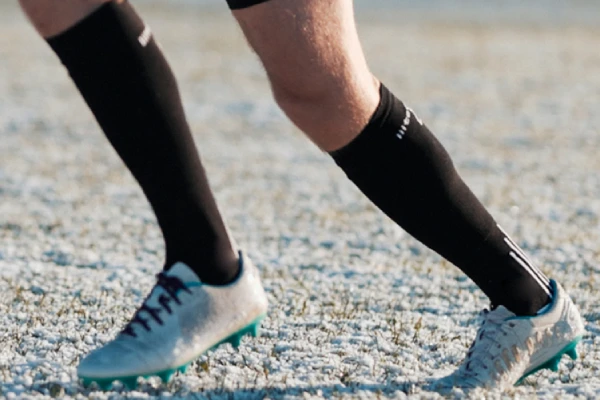
Problem they solve: Muscle fatigue, swelling, and poor recovery during or after games.
Who needs them: Athletes playing long matches, post-injury recovery users, or endurance-focused footballers.
How they work: Engineered to apply graduated compression (typically 15–30 mmHg) that supports the calf muscles and improves blood circulation.
Popular product examples:
- CEP Compression Socks
- 2XU Recovery Socks
- McDavid Sports Compression
Customization possibilities:
- Target pressure zones (calf vs. ankle)
- CE certification-ready design
- Color-zoned gradient compression to support branding
Padded Football Socks
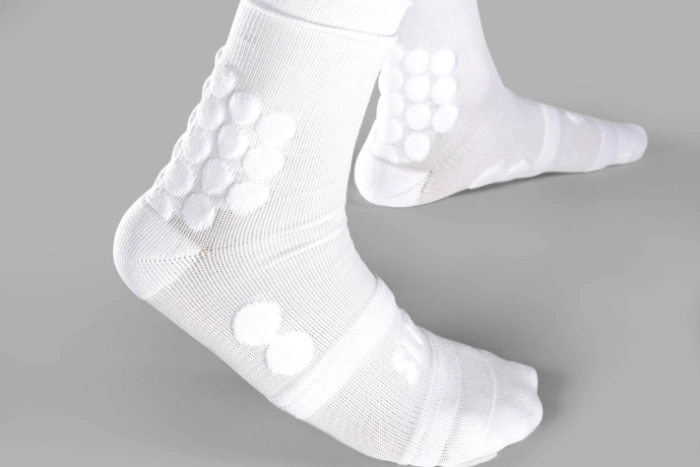
Problem they solve: Impact-related injuries or soreness from running, jumping, or sliding during matches.
Who needs them: Forwards, defenders, goalkeepers — anyone with high foot impact roles on the pitch.
How they work: Strategic cushioning zones at the toe, heel, arch, or ankle reduce shock and provide all-day comfort.
Popular product examples:
- Adidas Cushioned Match Socks
- Puma Padded Sports Socks
- Nike Everyday Plus Cushion
Material highlights:
- Cotton + spandex + foam-spun yarn blends for plush softness and structure
Customization possibilities:
- Choose zones for added padding (toe only, or full-sole)
- Split-padding designs for flexibility
- Technical weaving options for breathability + cushion balance
Reinforced & Durable Football Socks
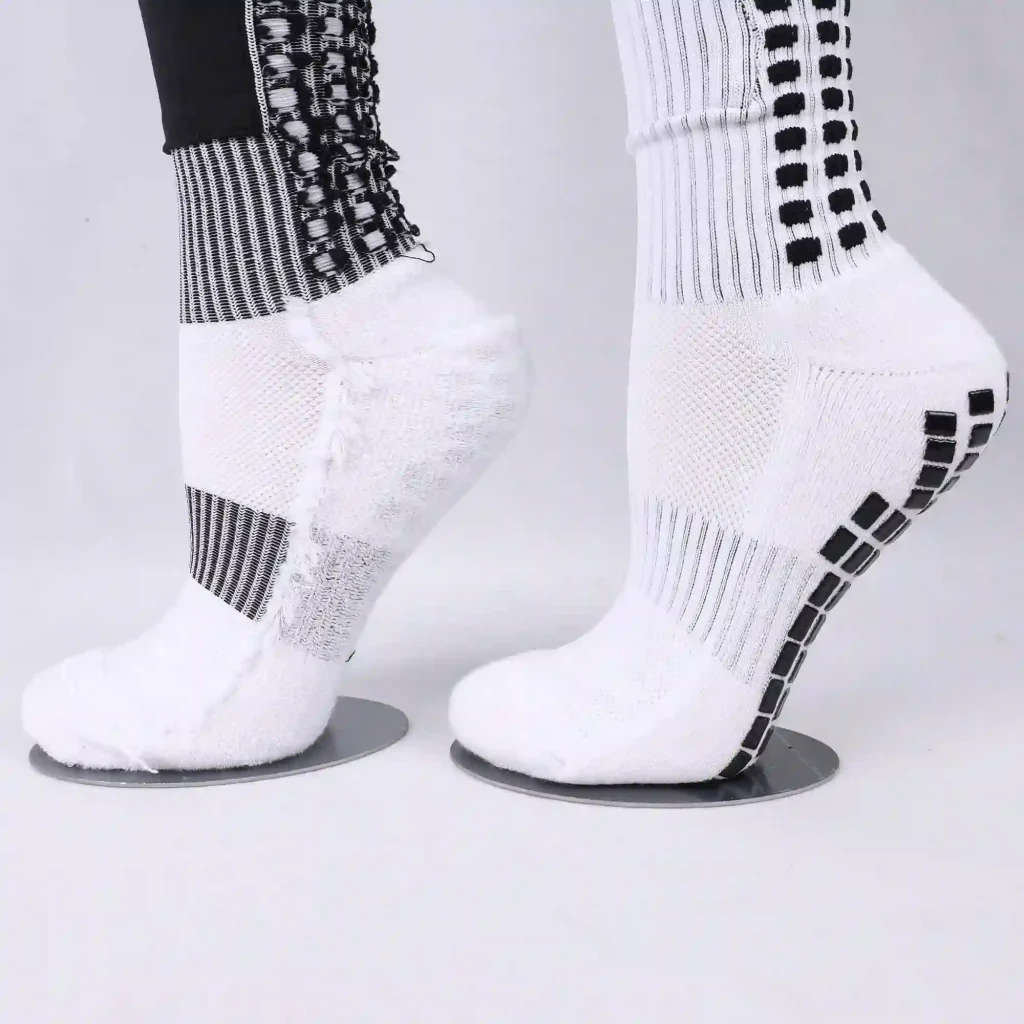
Problem they solve: Premature wear at high-friction areas like the toe box, heel, and arch.
Who needs them: Players with frequent matches and practice sessions, clubs needing long-lasting training kits.
How they work: Reinforcement through high-twist nylon, abrasion-resistant yarns, and denser stitching patterns at stress points extends sock life.
Popular product examples:
- Falke TK2
- Darn Tough Sports
- Nike Utility Performance Socks
Customization possibilities:
- Reinforced weave maps (toe, heel, sole)
- Abrasion-resistance test certification
- Color-coded reinforcement zones for style + function
Thermal Football Socks
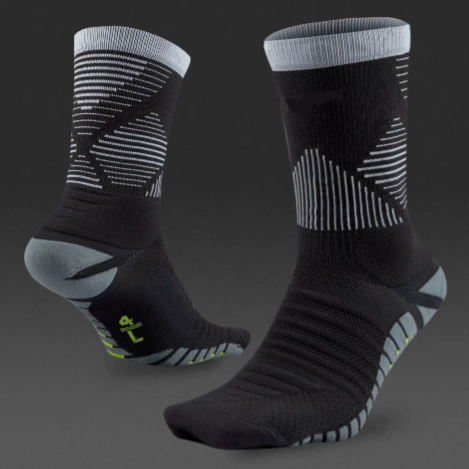
Problem they solve: Cold feet during winter training or matches in sub-zero climates, leading to numbness or reduced performance.
Who needs them: Clubs in cold regions (Europe, North America), outdoor winter leagues, players training in off-season.
How they work: Merino wool, acrylic, or brushed polyester create a warming effect while still maintaining breathability and stretch.
Popular product examples:
- Nike Thermal Performance Socks
- Under Armour ColdGear
- Smartwool Sport Socks
Customization possibilities:
- Zoned terry loops (toes, arch, calf)
- Dual-layer knitting for insulation + dryness
- Integration of thermal + moisture-wicking yarns in one sock
Seamless or Blister-Free Football Socks
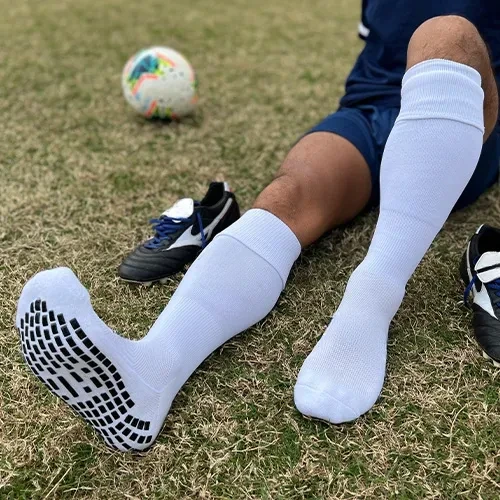
Problem they solve: Toe blisters and irritation from sock seams rubbing against the foot during long matches.
Who needs them: Players with sensitive skin, or those who wear socks all day (academy students, staff, etc.)
How they work: These socks are knit in a 360° seamless tube with a special toe closure that minimizes bulk and friction.
Popular product examples:
- Wrightsock
- Features Elite
- Balega Blister-Free
Customization possibilities:
- Softened cuff structure for comfort
- Multiple toe closure types (linked, flat-knit, hand-closed)
- In-shoe abrasion testing available for sportswear clients
Note: All the functional football sock types listed below can be customized in various lengths—ankle, crew, or knee-high—according to your brand’s style and player preferences. This flexibility ensures you can combine performance features with the right fit and look for your target market.
| Type of Football Socks | Problem They Solve | Customization Options |
|---|---|---|
| Moisture-Wicking & Breathable | Sweaty feet, heat, blisters | Mesh zones, absorbent yarn, team color matching |
| Anti-Odor & Antibacterial | Smell, fungi, hygiene | Antibacterial yarn, test reports, compliance support |
| Football Socks with Built-In Shin Guards | Extra shin gear not needed | Pad placement, sizing, full-color branding |
| Grip Football Socks | Slipping, unstable movement | Dot density, sole coverage, grip color |
| Compression Football Socks | Fatigue, swelling, slow recovery | mmHg level, calf/ankle zoning, CE-cert option |
| Padded Football Socks | Impact soreness, pressure spots | Pad zones, breathable cushioning |
| Reinforced & Durable | Holes, fast wear | Reinforced zones, abrasion testing, color marking |
| Thermal Football Socks | Cold, numbness, winter play | Insulation zones, hybrid yarns, double-layer knit |
| Seamless / Blister-Free | Blisters, seam discomfort | Toe closure, soft cuffs, in-shoe test results |
Selling Football Socks That Actually Solve Problems
For brands and retailers, socks are no longer just an afterthought in sportswear. They’re performance tools. Whether you’re targeting youth teams, pro-level athletes, or school sports programs, functional football socks help reduce complaints and increase customer loyalty.
If you’re planning to customize socks with specific grip, compression, or fabric technologies tailored to your market, our factory is ready to support you — from development to bulk production. Let’s build a sock that performs as hard as the players wearing them.
Send us your design or idea today.
FAQs
Can functional football socks be customized in different lengths?
Yes. Most functional football socks can be produced in ankle, crew, or knee-high lengths, depending on your brand’s needs and player preferences.
How do padded football socks protect players during intense matches?
Padded socks provide extra cushioning in key impact areas like the heel and forefoot, reducing soreness and lowering the risk of injuries from repeated running and sudden stops.
What benefits do grip socks offer compared to regular football socks?
Grip socks have silicone or rubber pads on the sole to prevent foot slippage inside boots, enhancing stability during fast movements.
Are compression football socks suitable for all players?
Compression socks are especially helpful for players involved in long matches or those recovering from injuries, as they improve blood flow and reduce muscle fatigue.
What makes seamless football socks beneficial for players with sensitive skin?
Seamless socks eliminate toe seams that often cause friction and blisters, offering enhanced comfort—ideal for players who wear socks for extended periods or have sensitive feet.
